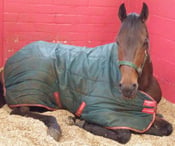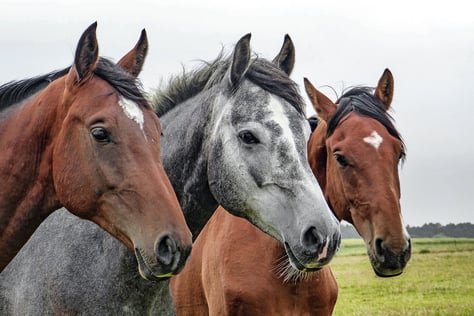 Most likely during winter, your frequency and length of ride time decreased quite a bit. Now you want to start enjoying longer trail rides or maybe competing in an upcoming show. This information can help to condition your horse after a lay off.
Most likely during winter, your frequency and length of ride time decreased quite a bit. Now you want to start enjoying longer trail rides or maybe competing in an upcoming show. This information can help to condition your horse after a lay off.
Just like with human athletes, horses must be conditioned properly when returning to work after a long hiatus. It's recommend to begin by concentrating on aerobic exercise first. Start with low intensity exercise preferably in short multiple sets per day. This will help build cardiovascular fitness and muscle tone/ memory while guarding against fatigue of tendons, ligaments, muscle, and joints.
A good place to start with a horse that has been laid off for 2-3 months would be:
- A 15 minute walk session - the longer walk warm up gives the horse plenty of time to stretch and get accustomed to the weight of a rider again.
- A 5 minute uncollected trot set – this allows the horse to build cardiovascular fitness.
- 10 minute cool down
- Do once in the morning and once in the afternoon.
Five minutes of uncollected trot and the five minute cool down allows the rider ample time to evaluate the horse’s fitness level by measuring the length of time it takes the heart rate to return to an acceptable level. If the heart rate remains elevated for longer than five minutes after the trot set, decrease the length of the trot to build up fitness. These short sessions limit the wear and tear on the horse and allow for two sessions per day so fitness is increased faster.
To build up aerobic fitness, the target heart rate is 150 bpm or greater. Normal resting  heart rate of a horse is 32-44 bpm. Normal heart rates vary between breeds and individuals. Knowing your horse’s normal rate is paramount. Fitter horses will have lower resting heart rates just like human athletes. Use the values to guide length of trot time during the starting stages of your exercise regimen. Then gradually add in canter work.
heart rate of a horse is 32-44 bpm. Normal heart rates vary between breeds and individuals. Knowing your horse’s normal rate is paramount. Fitter horses will have lower resting heart rates just like human athletes. Use the values to guide length of trot time during the starting stages of your exercise regimen. Then gradually add in canter work.
Heart rate response is the most accurate method to determine fitness. Heart rate monitors are commercially available, but can be costly. Using the help of someone on the ground, your horse’s heart rate can be easily measured. Using an index and third finger, a pulse can be easily felt under the mandible. Count for 30 seconds and multiply by 2 to calculate beats per minute (bpm). Calculations made from counting for only 10-15 seconds produce greater error. In addition to heart rate, respiratory rate, gum color and texture, presence and amount of sweat, and rectal temperature are all good parameters to measure.
In addition to cardiovascular fitness, it is also important to remember your horse will be building musculoskeletal fitness. Short periods of cyclical loading like multiple short duration sessions of moderate intensity exercise are best. This type of work reduces the incidence of stress fractures and reduces the strain on boney structures.
Many veterinarian and trainers are in favor of “two a day” workouts. Short workouts twice a day are great for increasing aerobic fitness quickly while limiting the stress on the musculoskeletal system. They also allow the horse’s epaxial (back) muscles to get used to carrying an actual load again. Remember over the winter your horse has lost some of his topline. His muscles have changed, check saddle and pad fit carefully. The fit will more than likely change once or twice during all of this conditioning so be prepared to make tack changes as the need arises.
The best advice to equestrians getting back in the tack- BE FLEXIBLE. This is a dynamic process and an individual one. No one horse will regain fitness on the same schedule as the next and no two horses will be starting from the same point. Show good horsemanship - know your horse and adjust to what he needs. Problems arise when there is poor planning and a cookie cutter agenda.
<span style="color:#000000;">Photo credit: HorseChannel, HorseandHound</span>



